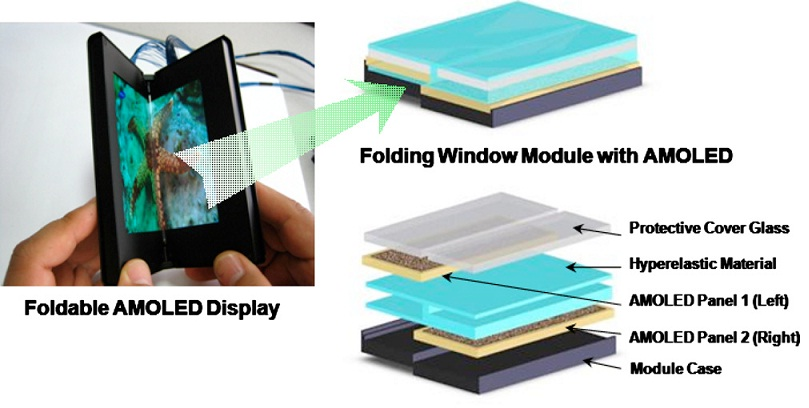Researchers in a laboratory from Samsung introduced an AMOLED display can be folded more than 100 000 times without showing signs of wear. These are actually two screens joined by a hinge. The novelty lies in the use of a flexible material to give the illusion of a continuous screen. The results were published earlier this week in the journal Applied Physics Letters.
So far, it was impossible to conceal the hinge. We met up with two screens and is an important edge in the middle, with a slab or flexible, but difficult to fold. To give the illusion of a large folding screen, Samsung has been working on a new hinge. This is a hyperelastic material silicone rubber that covers the entire visible surface.
The Korean then placed a slab AMOLED above and below the second plate of the hinge. The slabs are then covered with a tactile surface that serves as a protective layer. After 100,000 cycles of opening and closing of the camera, the brightness at the center of the screen had declined by only 6% and no trace of cracks or wear was visible.
The radius of curvature of only 1 mm gives a folded almost flat surface. This is not the first time that Samsung shows flexible displays, but it is interesting for two reasons. The first is the use of two small plates instead of great. Indeed, research has generally focused on a screen thin enough to be pliable, but this kind of tile is very difficult to produce (see "A foldable OLED display in a phone").
Another interesting detail is the use of silicone rubber instead of the traditional plastic that we find so often (see "Flexible AMOLED Screen Samsung" for the latest example from Korean). This material is stronger and more flexible. This new approach is impressive, but nobody talks about marketing again. 


So far, it was impossible to conceal the hinge. We met up with two screens and is an important edge in the middle, with a slab or flexible, but difficult to fold. To give the illusion of a large folding screen, Samsung has been working on a new hinge. This is a hyperelastic material silicone rubber that covers the entire visible surface.
The Korean then placed a slab AMOLED above and below the second plate of the hinge. The slabs are then covered with a tactile surface that serves as a protective layer. After 100,000 cycles of opening and closing of the camera, the brightness at the center of the screen had declined by only 6% and no trace of cracks or wear was visible.
The radius of curvature of only 1 mm gives a folded almost flat surface. This is not the first time that Samsung shows flexible displays, but it is interesting for two reasons. The first is the use of two small plates instead of great. Indeed, research has generally focused on a screen thin enough to be pliable, but this kind of tile is very difficult to produce (see "A foldable OLED display in a phone").
Another interesting detail is the use of silicone rubber instead of the traditional plastic that we find so often (see "Flexible AMOLED Screen Samsung" for the latest example from Korean). This material is stronger and more flexible. This new approach is impressive, but nobody talks about marketing again.



- IGNIS Innovation Inc. Demonstrates World's First Amorphous Silicon AMOLED Product at SID Display Week 2011 (17/05/2011)
- No creases on Samsung's latest foldable AMOLED display (13/05/2011)
- iSuppli: 49.4 million AMOLED displays were shipped in 2010; 271.2 million will ship in 2015 alone (17/05/2011)
- Samsung shows foldable AMOLED display (13/05/2011)
- Samsung flexible AMOLED display won't crease, try as you might (16/05/2011)
No comments:
Post a Comment